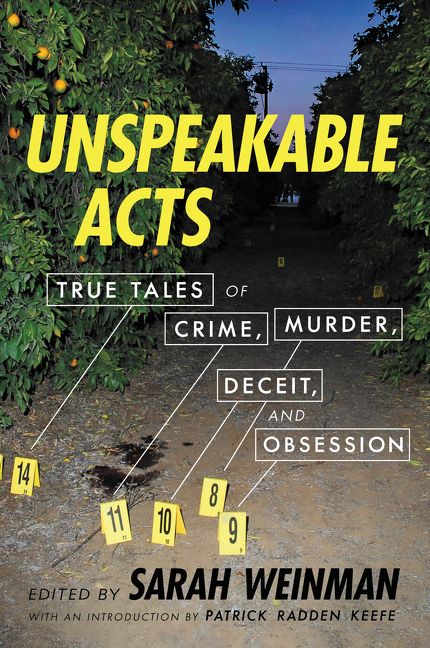When I was in fourth grade, kids told stories about a killer who was supposedly stalking the area. This was in Milton, Massachusetts, a suburb of Boston, in the mid-1980s. The man drove a Chevy Nova and carried a knife, my classmates said. He was known as the Milton Quincy Stabber. I don’t have many specific recollections of fourth grade, but I can vividly remember walking out of art class, positively vibrating with terror. The stabber was at large, in our area, and would almost certainly stab again. I suddenly became attuned to the make and model of every approaching car, though the Milton Quincy Stabber was said to direct his violence only at women.
If I ever learned what became of the Milton Quincy Stabber, I have forgotten. Which is strange, when you think about it, because even as children, we are drawn to the puzzle of crime narratives, and if we read them compulsively it’s often because we feel compelled to hunt for a solution. My favorite part of any Sherlock Holmes story was always the final scene, when the great detective reassembles the random clues into a coherent narrative that is legible only in retrospect. Was the stabber apprehended? If I bothered to find out as a kid, the memory hasn’t lingered. What has stayed with me, indelibly, is that first vicarious brush with the concept of random murder: the whiff of mortal fear, the revelation that sometimes life doesn’t stretch out before you in an unbroken path to old age. Sometimes it terminates, abruptly, when a stranger pulls over in his Chevy Nova.
A few years ago, I spent some time back in Massachusetts to report the story of an unrelated killing, and while I was there, I started thinking about the Milton Quincy Stabber. When I ran the phrase through Google, however, nothing came up. My mind flipped through a sequence of bizarre explanations. Had one of my fourth-grade classmates invented the stabber? This was a feature of childhood before the advent of the search engine: nobody fact-checked anything. Wild legends circulated, like the one about the untimely death of little Mikey, who made the suicidal mistake of mixing Coke and Pop Rocks. But could someone have invented a serial killer? Even as I weighed this possibility, a more troubling scenario presented itself: Could I have concocted the story myself? As a child, I had a febrile imagination—not a fantasy life per se, but the attention of an actuary to the probability of improbable catastrophes. I slept with the lights on for years. Could I have somehow fantasized the stabber?
I mention all this because the whole episode captures two distinct elements of our relationship with stories about real crimes. The first is that from childhood, we are hardwired to be fascinated by danger, and by the dark potential of other humans.
When you read a Patricia Highsmith novel, the abyss of human depravity into which you peer runs only as deep as Highsmith’s imagination.But a true story of human cruelty engages—and implicates—the reader in a more profound and unsettling way.
The most engaging crime stories often take the form of a mystery or a thriller. But if they’re true, they are also, almost always, tragedies.The story of the Milton Quincy Stabber was also a story, with the familiar contours of a fairy tale: a predator, a string of innocent victims, a hunting ground that children should avoid. If “true crime” is enjoying a renaissance at the moment, I think it is at least in part a function of narrative modalities: bingeable, long-form, serialized storytelling lends itself particularly well to tales of investigation. At the same time, any journalist seeking to incorporate the truth of an actual crime into some engaging narrative construct must contend with very real moral hazard. The most engaging crime stories often take the form of a mystery or a thriller. But if they’re true, they are also, almost always, tragedies. The more lurid the story, the more likely the victims—and the real human costs of the crime—are to be forgotten.
For the crime reporter, certain forms of selection bias can also take hold. “Narrative” tends to mean characters—protagonists and antagonists, conflict and motivation—and crime writing has historically favored certain sorts of characters (white female murder victims, to take the most glaring example) to the exclusion of others. There’s a subtler danger, too, when we focus on stories of individual characters and crimes, because the greatest crimes, now and always, have been systemic, and systemic stories are harder to tell. One conspicuous upside of the current boom in crime reportage is that it has created space and demand and recognition for writing about crime that is more representative—and for an approach to crime writing that grapples more overtly with these risks. On both counts, the collection you are about to read is exemplary and overdue.
As I was preparing to write this introduction, I searched one more time for the Milton Quincy Stabber, and found an article I’d missed when I looked before, a UPI story from January 1987, with the headline, “Hunt for Stabber Intensifies.” Over a three-week period that winter, a man named William Marguetty stabbed four women in Milton and Quincy. They all survived, but before he was apprehended that March, he murdered a twenty-seven-year-old named Ann Gillietti. She was found stabbed to death in her apartment in a Roslindale housing project. In a typical failure of crime reportage, I could find hardly any information about Gillietti online, apart from the fact of her murder—and the terrible detail that she was not alone in the apartment when her killer arrived; her two-year-old daughter was with her and survived the attack.
Marguetty was eventually convicted of murder and attempted murder, and sentenced to life in prison. He had ar- rived in the United States on the Mariel boatlift in 1980, after being released from a prison in Cuba. “Victims have provided different descriptions of the attacker’s car,” the UPI reported. But two of the women said it might have been “a rust-colored Chevy Nova.” I hadn’t imagined the story, nor had my classmates. We just had the wrong dime-store nickname. In the press, Marguetty wasn’t the Milton Quincy Stabber but the South Shore Stalker.
*



















